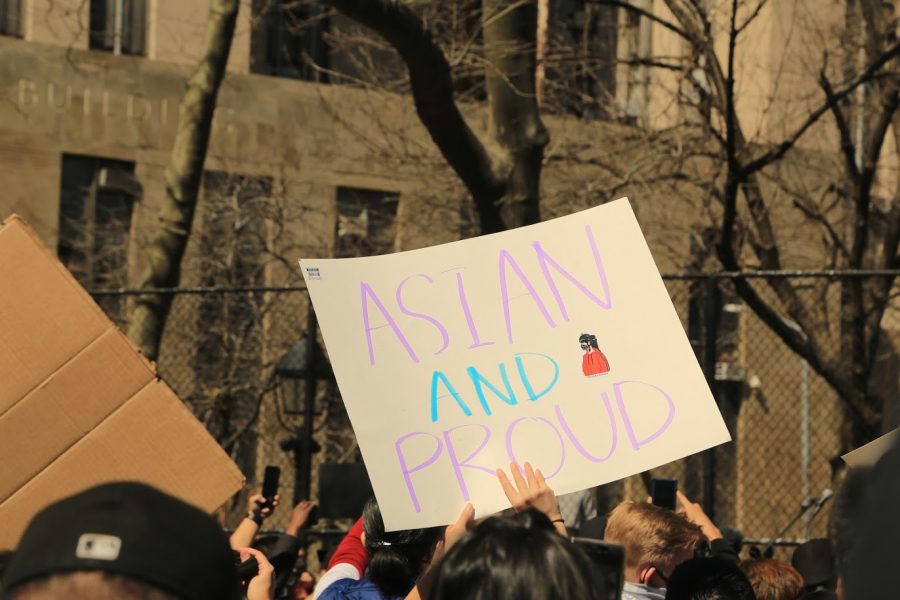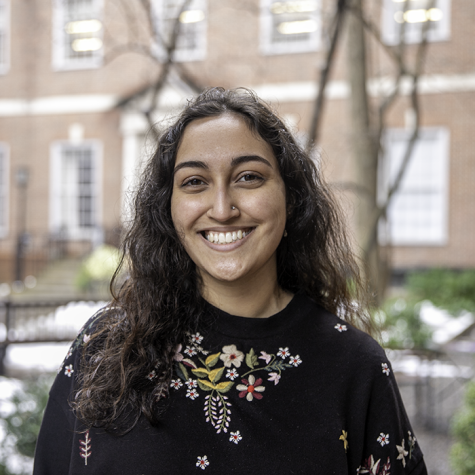API students wrestle with whether they are Asian enough
Pandemic-related hate and the response of the Stop AAPI Hate movement have made some students question whether they count as API. This article is the third in Sabrina Choudhary’s series documenting Asian and Pacific Islander students’ experiences with race at NYU.
NYU students of Asian and Pacific Islander descent are sharing their experiences with racism in New York City during the pandemic. The past year’s pandemic-related hate has targeted some students under the AAPI umbrella while sparing others, causing some who have not faced heightened racism to question whether they count as AAPI. (Photo by Suhail Gharaibeh)
May 3, 2021
May is Asian American and Pacific Islander Heritage Month in the United States. This year, the celebration comes after thousands of hate incidents against Asian and Pacific Islander people were reported during the pandemic, a figure that is assumed to be an underestimate. Anti-API hate crime reports went up by almost 150% between 2019 and 2020, even as the overall hate crime rate fell. New York City saw the greatest increase of any major U.S. city.
While NYU’s API students come from an enormous range of backgrounds, racism functions by reducing those nuances to perceivable traits — namely, appearance. The past year’s hate has targeted some students under the API umbrella while sparing others, causing those who have not faced heightened racism to doubt their validity in the API community.
Crystal Parikh is a professor in the Social and Cultural Analysis and English departments as well as the director of NYU’s Asian/Pacific/American Institute. Her work addresses the complicated histories behind the formation of these identities.
“I spend a lot of time with this category of ‘Asian American,’ or ‘Asian Pacific American,’” she said. “The larger context of history of that category is one that’s been vexed from the very origins.”
She explained that Asians didn’t immigrate en masse to the United States until 1965 due to the government’s anti-Asian discrimination.
“Most of the 20th century is just one Asian exclusion act after another,” she said. “Basically from the early 20th century until 1965, there’s just no immigration from Asia to the U.S. Not because it’s an accident; it’s by design. The Congress and the federal government arranged that.”
This history means that API and AAPI are terms that only emerged within the past few decades to describe a relatively new population in the United States. As a result, people are constantly defining and redefining these identity categories. The recent flood of hate has become a new moment to grapple with who these labels include and exclude.
Parikh also suggests that the anti-API hate we’ve seen could be a result of contemporary anti-API sentiment at the state level.
“Much of this might very well be rooted in a kind of anti-China rhetoric from the top down,” she said. “But it’s not only Chinese Americans or Chinese immigrants. Those who are bearing the brunt of it is the whole range of Asian Americans and, I think, Pacific Islanders.”
Tisch sophomore Anvita Gattani, who is Indian American, added that people commit hate crimes based on their perceptions of the victims, not the victims’ actual ethnicities or identities. Even if the aggressor’s logic is founded in anti-Chinese racism, they only care about whether the person they’re attacking fits their conception of how a Chinese person looks.
“They don’t look at someone and be like, ‘Ah, they’re Korean. The coronavirus did not come from Korea. Let me not hate-crime them,’” she said. “The oppressor doesn’t necessarily see the individuality of the communities.”
By the same token, many students who consider themselves Asians or Pacific Islanders are hesitant to claim space in the Stop AAPI Hate movement because they have not been the targets of pandemic-related hate. On top of that, many have felt excluded from the API community because their experiences don’t fit what the term has come to signify to others. Both of the Indian students I spoke to said that South Asians are treated as separate from the API umbrella.
Tisch junior Inaya Carroll, who is Canadian and half Indian and half white, doesn’t think she should be included in the Stop AAPI Hate movement.
“These attacks have been on East Asians and Southeast Asians, and I’m half South Asian, and very fair for a South Asian, and I understand that. I understand a lot of the time South Asia gets forgotten as a part of Asia,” she said. “This isn’t for me. I don’t feel like I’m included in this at all.”
Gattani expressed a similar sentiment.
“I consider myself to be AAPI, but it’s also interesting that India as the subcontinent is often excluded from those conversations, and Indian Americans are told kind of like, ‘Go find your own place,’” she said.
Other students feel that while those experiencing pandemic-related hate should be prioritized within the movement, gatekeeping is problematic in other ways.
Caroline Younglove is a junior in Tisch and CAS. As a biracial American who’s half Filipina and half white, the Stop AAPI Hate movement has intensified her search for a racial identity.
“Being half and half, sometimes I feel like I have experienced anti-Asian racial profiling and hate and comments like that, but that was in my past. And now, I guess I’m coming to more of a reckoning of finding my identity as a person of color, and I’m not really sure where I land,” she said.
For Younglove, the notion of being “enough” to count as an API person is dangerous.
“I think there shouldn’t be a barrier on, ‘Oh, you aren’t Asian enough, you don’t look Asian enough,’” she said. “There’s a whole thing about not being enough to identify as a race or ethnicity, which I think is very harmful for a lot of people.”
For Gallatin junior Carlisle Wang, who is Chinese American, this attitude is apparent when people of Asian descent define their identity by their migration from a different culture and homeland. As a result of the United States’ anti-Asian immigration legislation up to 1965, 57% of Asian Americans in 2021 are immigrants, compared to 14% of the entire U.S. population. Wang says that the Facebook group Subtle Asian Traits, which has nearly 2 million members from around the world, roots Asian identity in this kind of experience.
“[It’s] just a little exclusive to people who are maybe not second-gen or first-gen, people who are a little more disconnected from the ‘home country,’” he said. “That’s kind of also implying that America does not count as a home country, even though I was raised here.”
Even if this gatekeeping is implicit, it can weigh heavily on those who are excluded.
Tisch senior Alyssa Silver is an American of Japanese and Jewish descent and a co-founder of the Tisch club All Asian Arts Alliance. After the Atlanta shooting, she felt conflicted about whether she was part of the API community in mourning for the victims.
“I talked with someone else who was mixed in the club and they said, ‘Can we even claim this grief? Are we allowed to claim this grief?’” Silver said. “I think we are allowed to claim it because it’s part of our identity, but it was still hard to grapple with.”
These kinds of questions are why she intentionally creates space for other mixed people in her club.
“Something I’m really passionate about within my club is to make sure mixed kids have a space in the club, and they know that they’re accepted no matter what,” she said. “Because I know what it’s like to be not accepted within an Asian community, even though you’re Asian.”
Steinhardt senior Sinead Anae is a Pacific Islander of Native Hawaiian, Samoan and Irish descent. She believes that while most of the hate we’ve seen during the pandemic has targeted Asian people, and while the term AAPI emphasizes Americans, using the term AAPI in anti-racist activism is an important step towards inclusion.
“The acronym itself is extremely powerful, to include Pacific Islanders,” she said. “I hope that people understand that it is a different experience, though, and that’s why it’s important to still have that intersectionality.”
Gattani agrees that it’s crucial for API people to build a coalition while acknowledging their unique and layered identities.
“I think it’s important to recognize that there are several identities that experience Asian discrimination differently,” she said. “I think individuality is important, but I also think it’s important to band together as a community under an AAPI type of term.”
This year, AAPI Heritage Month is an especially meaningful time to embrace identity in all of its complexity and to make space for those who don’t feel like they belong.
“I think being an Asian in America, that identity is being opened up right now,” Younglove said. “It’s just about this country’s identity as a whole because it’s so shifting, and I think we are finding ways to include more people. It’s still, it’s hard for people who fall in an in-between, I think, to find a space in conversation.”
A version of this article appeared in the Monday, May 3, 2021 e-print edition. Email Sabrina Choudhary at [email protected].

























































































































































